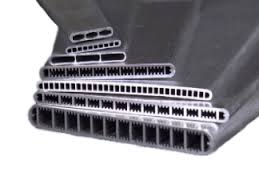One radiator company is now touting a “revolutionary advancement in cooling technology”. A bold statement like this deserves to be investigated...

What is this big break through? it is Extruded Cooling Tubes (ECT) and it is not that revolutionary. In fact it’s not even new, as this technology has been around for many years. ECT has been popular in high pressure oil systems and Charge Air Coolers (CAC) coolers for more than a decade. ECT is made by heating and pressing aluminum material through special dies to create a custom shape. It is very difficult to form these tubes with thin wall thicknesses. Typical wall thickness on this type of cooling tube runs between .020”-.040” which is thick for cooling. The heavy tube wall thickness and internal trusses provides the strength which can hold higher pressures.
 Roll form tubes (RFT) are the gold standard in automotive cooling. Every major auto supplier today uses RFT because the thinner wall will transfer heat better and reduce unnecessary weight. The typical wall thickness range for RFT is .010”-.015”. This design will hold pressures as high as 45 psi without tube distortion, providing a pressure safety factor of 300% when pressurizing the cooling system to 15psi.
Roll form tubes (RFT) are the gold standard in automotive cooling. Every major auto supplier today uses RFT because the thinner wall will transfer heat better and reduce unnecessary weight. The typical wall thickness range for RFT is .010”-.015”. This design will hold pressures as high as 45 psi without tube distortion, providing a pressure safety factor of 300% when pressurizing the cooling system to 15psi.
The same company is stating that (at 100 psi) this ECT technology is “more than triple the burst pressure of any other performance aluminum radiator in the world!” Well, let’s take a look at that claim. DeWitts Radiator LLC has resisted the industry tread to use thinner tubes and fin to save money on material. We have stayed with proven (.013” 26mm) and (.015” 32mm) wall tubes when most companies are running .003” thinner. We also continue with .005” fin material when others are using .003-004”fin. This may not sound like a big difference however our design will hold 60 psi without tube distortion and 100 psi without bursting. So I guess you could say that’s “out of this world” performance!
Another misleading item is the “55mm Core with Twelve (12) 4mm Wide Tubes” feature. Well, that is creative however they really only have one (1) tube that is 55mm wide. This tube is called a multi-port design with twelve 4mm paths for the coolant to flow. Due to the heavier tube wall thickness, the inside diameter is 25% smaller than a standard double row 26mm core.

Extruded Tube Calculations: 12 paths @ 0.1570” x .0394 = 0.0742 Square Inch Area = 0.307” hole diameter.
Rolled Tube Calculations: 2 Paths @ 1.0 x 0.054” = 0.108 Square Inch Area = 0.370” hole diameter.
In conclusion, the ECT design will be heavier, run hotter, and have a higher pressure drop than a standard double row 26mm design radiator. The only clear difference of an ECT is the higher burst pressure. Since all automotive applications run in the 10-20 psi range there is really no advantage and several disadvantages.
Feel free to post your comments by filling out the form below. If you have any questions that require a reply click here. Note that questions posted in the comment form will NOT be replied too.


